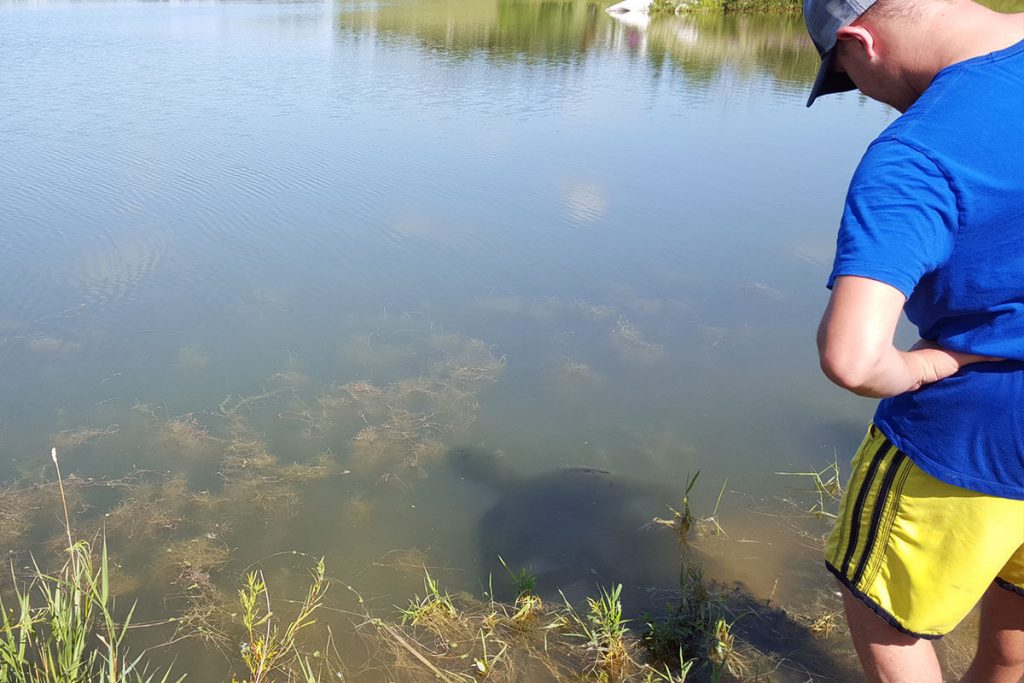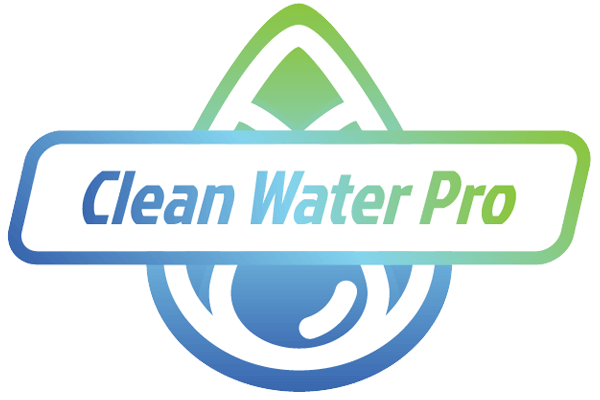Diagnosing issues early in your favourite lake or pond can save time, money, and a lot of grief!
Did you know there are a few simple things you can do to make a preliminary assessment of the health of a given body of water?
Proper water management should always start with an assessment of the current conditions. It’s an important process that should be repeated on a regular basis to ensure potential issues are spotted early and dealt with in a timely manner.
Use this handy checklist to assess your pond!

- Clarity – is the water clear or cloudy?
Pond water that is cloudy-looking, muddy, or opaque is the result of high turbidity. Turbidity means that there is dissolved or suspended organic (plant/animal origin) or inorganic (soil, minerals) matter in the water.
You can do a visual assessment of the colour and quality of the water by looking across the body of water to assess the colour and then down through the water column to the bottom. The water should appear light blue or slightly green but mostly colourless, with no floating debris on the surface.
Muddy, turbid water with high inorganic solids throughout is usually the result of the bottom of the pond being regularly disturbed. You can do a quick check for this by taking a jar of the water and letting it sit for 24 hours. If the water becomes clear with sediment on the bottom of the jar then you have proven that the pond is receiving significant mixing often enough not to let it settle. This can be from people or pets swimming in the pond frequently, animals like cattle or deer stepping into the water to drink, animals like muskrats digging in the pond, or too many fish for the pond space creating too much waste in the water or digging in the pond bottom, etc.
Turbidity can also be the result of decaying algae suspended in the water column or too much fish waste in the overcrowded water.
A common issue is the sides of the pond being eroded and dirt being constantly washed into the pond by rainfall and wind action. Water movement from waves can erode the pond banks and constantly add dirt to the pond. This can be remedied by adding rip rap or gravel to the pond edges to control this erosion.
To get some data on the conditions of the water a sample can be taken with a small sterile jar and sent away for assessment by local professionals. The type of assessment required is will be determined by the type of tests you select on the lab requisition form, and this may be a question you need to ask professionals to assist you with to ensure that the appropriate lab tests are requisitioned and interpreted. It can be costly to order lab tests that won’t benefit your situation.
- Algae cover – do you have any? How much of the water is covered?
If there is an algae bloom or huge patches of floating algae on the surface of the pond, then there needs to be pond aeration and filtration to cut down the effects of these small plants in the water. If you have existing aerators and filters, then this equipment needs maintenance immediately.
Algae can die off suddenly during cloudy periods when these small aquatic plants don’t receive adequate sunlight. Algae dieback can be harmful to the pond’s other inhabitants and can lead to fish dying. Some types of algae can be poisonous and harmful to people, wildlife, birds, and aquatic inhabitants.
- Pond size, age, and design features
Assessing the bottom structure of your pond will give you information about the water quality and is a good indicator of the health of your pond. Newer ponds may need time to settle and become clear and healthy.
Water features can have cement, pool plastic, or other pool liners. These pool liners degrade and can begin to leak over time. If you frequently have to add water to your water feature, then consider draining the pond and doing a visual inspection of the liner. This may be too big a job for most homeowners, and professional advice and equipment may be required.
Dugouts, natural water collection sites like ponds, can have a natural dirt bottom or a gravelled bottom. These too may degrade over time and require inspection and relining with clay and gravel to maintain their integrity.
Some pools and dugouts can have a sandy bottom over clay or bedrock. These can be easier to manage but may still need occasional inspections, cleaning, and maintenance.
The bottom of the pond can be a part of your water management that may need attention if there is constant ingress of leaves, dead water plants, and debris being submerged on the bottom of the pond. The pond will become shallower, and that will create warmer water conditions that will bring on algae blooms, may lead to fish die-off, and may create hazardous muddy conditions. Dredging your pond may be something that has to be done to maintain the water quality and usefulness of the water feature.
- Water depth, water source, frequency of water additions
The water depth is something that should be maintained and monitored over time. If the water is constantly dropping, then that situation may call for pond liner maintenance because the pond is leaking from the bottom.
- Surrounding infrastructure – trees can drop in leaves that will rot, and shady or full sun can change the water temperatures
While trees around a pond can be very visually appealing, they can also create more work for you in maintaining the pond or water feature as leaf litter can definitely negatively affect your water quality
- Water evaluations you can do yourself – oxygen levels, pH
Oxygen levels in a pond are very important to the living organisms in the water. Dissolved oxygen levels will fluctuate with the time of day that the water is tested, the amount of shade or cloud cover, the temperature of the water, the number of fish and other organisms using the oxygen, the amount of decaying material in the water, etc. You can use a dissolved oxygen meter and sensor to take a reading of the dissolved oxygen in your pond. If you don’t have a sensor, then contact a company that specializes in pond reclamation and maintenance and ask for assistance. The pH or acidity is also an important aspect of water management that requires periodic assessment. An aquatic organism does best in water around 5-9 in pH. A pH meter or pH sticks can be used to determine the pH of your body of water. Many companies sell water quality test kits, and this may be something you wish to invest in as part of your pond management toolkit.
- Status check and maintenance of your current filtration system
If you have a filtration system in your pond, then annual and seasonal maintenance will have to be part of your normal yard maintenance routine. Filters need to be cleaned and replaced often to maintain effective filtration and keep the water quality acceptable. Every situation will differ based on how big your pond is and how much the ingress of foreign particulates is creating filtration issues for you.
- Status check and maintenance of your current aeration systems
There are myriad different types of pond aeration systems, and each individual situation will require a different solution. However, whatever system you currently use should be annually evaluated as part of your maintenance program. In some cases, older systems may need to be upgraded to cope with the changing pond conditions and weather.
- List of additives to the pond: chemicals, herbicides, fish additives like algae eaters, etc.
It’s important to keep a list of all the chemicals used in or around your pond as these can affect the quality of the pond water and can cause issues you later encounter. This list can help you in case you require a professional to assist you in discovering the cause of problems with water quality in your pond. Sometimes there is a cascade effect caused by the interactions of herbicides, pesticides, and plant dieback that can overwhelm the pond ecosystem and create poor water quality.
- Do you have fish kill in your pond? It can occur for a number of reasons
Fish kill can occur when oxygen levels get too low, when water temperatures fluctuate, and when water becomes contaminated by things like leached pesticides. Overcrowding of the fish inhabitants may also cause poor water conditions that can result in a collapse of the pond ecosystem and die-off of sensitive fish.
- Are your pond plants healthy? Dead or dying pond plants are a bad sign
You may need to have a professional evaluate this situation, as it could be water quality or things like chemicals or herbicides leaching into your pond and killing them.
- What is the status of plants in the water – are there cattails, lily pads, swampy grasses, or lythrum?
Some water plants are desirable, and others indicate that your water is not healthy and requires more management. Cattails are an example of a plant that when present in large numbers can quickly proliferate and overrun your pond and create a swamp with no open water. In some cases, you may have to resort to herbicides or mechanical means like diggers to control unwanted plant populations in your pond.
Protecting and maintaining your pond ecosystem is vital to the health, beauty, and longevity of your water feature or pond. The pond ecosystem is as important as maintaining the water quality of your pond. Check out our blog The Health Risks Associated with a Stagnating Body of Water to learn why you should be evaluating your body of water.
Going over this checklist regularly and evaluating your pond and its current status is a good way to assess future projects required to maintain your water quality. If after going through this list you discover that there are significant issues to investigate that are beyond your capabilities to address, there are professional companies that can assist you in your endeavour to protect and maintain your water feature, dugout, or pond.
Note: Keep this checklist on hand and use it as an assessment tool regularly throughout the season. Maintaining water quality is an ongoing job but one that is well worth the time and effort.
